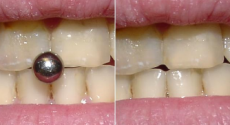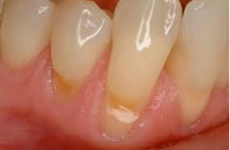The Worn Dentition Part 1
Throughout the years I have seen numerous cases of teeth that look like these examples. Frequently these patients will say things like, “I don’t really like my smile.” or sometimes they will say “My teeth are chipping can you fill them?” They rarely understand the significance of the symptoms they are experiencing and often they have multiple causes associated with their condition. These cases can be some of the hardest cases in dentistry to properly treat. This month, I want to take a little time to explain the causes of tooth wear along with the common signs and symptoms.
Fig 1
Fig 2
Fig 3
Fig 4
Fig 5
Tooth wear is broken into three categories. Attrition, Erosion, and Abrasion.
Fig 1: Attrition is tooth wear resulting from contact between opposing teeth. This will often demonstrate as flattened teeth with matching worn areas, chipping, fractures, mobility, and large chewing muscles. Often this is increased as we grind and or clench our teeth. Figure 1 clearly demonstrates attrition with the worn and chipped front teeth and a flattened puzzle like bite.
Fig 2: Erosion is a gradual tooth-surface loss process caused by an electrolytic or chemical mechanism without bacteria being involved. The acids causing the erosion may be extrinsic via our diet and habits or intrinsic when we have GERD and or a lack of salivary flow. If you are demonstrating signs of erosion then it is important that you see your physician to check for esophageal reflux. This kind of wear will be located in areas where teeth do not even contact each other.
Fig 3: Abrasion is the wearing away of the tooth’s outer covering caused by mechanical forces from a foreign object. Often this will be caused by a habitual action that chips or wears the tooth in a way to accommodate the habit. Things like pens, fishing line, and sewing needles have been known to create abrasive lesions.
Fig 4: “Toothbrush abrasion” has long been blamed for gum line lesions like those in Fig 4 but now are thought to be a combination lesion of clenching/grinding in a high acidic environment combined with aggressive brushing.
What’s the big deal about a little wear? Well early on a little tooth wear is not a big deal, but if left unchecked over a life time it can be catastrophic (Fig 5). It can also represent serious systemic issues that require medical treatment or behavior modification to properly treat. Eventually one may experience, a loss of function, potential Jaw joint dysfunction, potential root canals, crowns, or even removable dentures to treat the condition. Often when worn dentition cases become painful or problematic for the patient they are so big and require such work that the cost can be a limiting factor.
Next month we will focus on solutions for these problems. If you recognize these symptoms in your own mouth then I would encourage you to ask some questions the next time you see your dentist and or physician or feel free to stop by our office and schedule a consultation or exam.
Lastly I wanted to recognize Dr Ed Warr from Today’s Dentistry volunteered on the Ashland Dental Van in August. This is the second Dental Van visit for our community. It provides free dental services to Ashland residents who are in need. If you see Ed Warr around be sure to thank him for his contribution. For questions regarding access to the van please contact Pam at the Ashland Food Bank.







